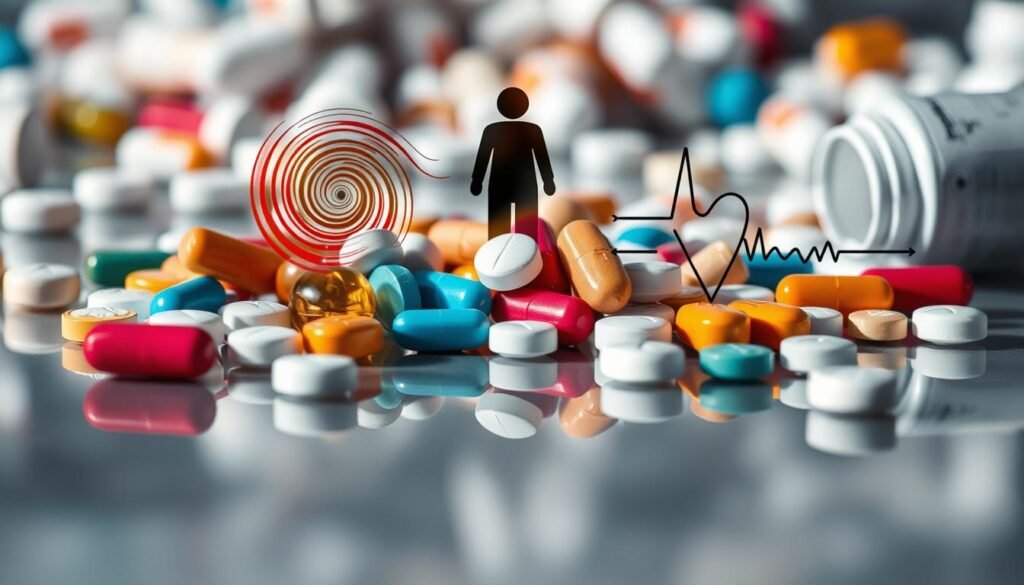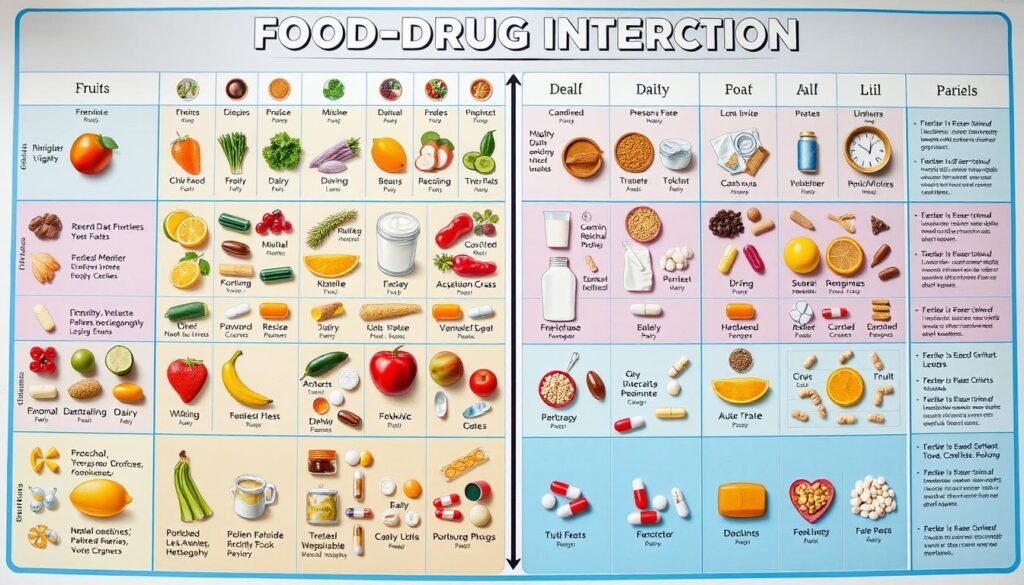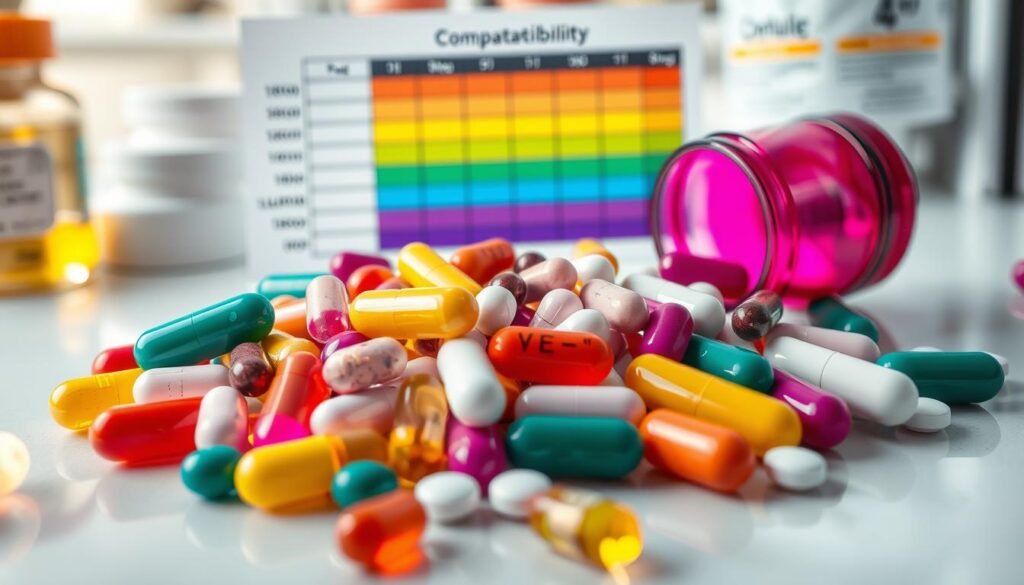Did you know that nearly 75% of U.S. adults use dietary supplements? Many don’t realize the risks of mixing these with prescription meds. The dangers grow for older adults who often need several medications for health issues. Adding just one more drug can significantly increase harmful side effects.
Understanding each medicine and how it reacts with others is key. This knowledge is vital for keeping healthy and avoiding bad reactions.
Key Takeaways
- Understanding drug interactions is crucial for medication safety.
- Polypharmacy increases the likelihood of adverse effects.
- Older adults face unique challenges with medication management.
- Communication with healthcare providers can reduce risks.
- Keeping an updated list of medications helps avoid harmful interactions.
- Dietary supplements can interact with prescription medications.
Understanding Drug Interactions
Drug interactions can have a big effect on health. They happen when drugs affect each other’s action or side effects. Knowing different types of interactions helps manage medications safely.
Types of Drug Interactions
There are several drug interaction types:
- Drug-drug interactions: These occur when drugs interfere with each other, changing their effects.
- Drug-food/beverage interactions: Certain foods and drinks can change how drugs work. For example, grapefruit affects some medication’s metabolism.
- Drug-condition interactions: Some health conditions can influence medication effectiveness. It’s important to consider the patient’s health history.
How Drug Interactions Occur
Pharmacodynamic interactions and pharmacokinetic interactions are two ways drug interactions happen. The first relates to how drugs’ effects mix, which can be good or bad. The latter affects how a drug moves through the body, changing its impact. Important considerations include:
- Changes in the stomach’s acidity and movement.
- Effects on drug transport proteins.
- Changes in liver processing of drugs.
Making sure drugs work well together is key. This involves looking at the patient’s drug history, other possible treatments, and the doctor’s experience with drug interactions.
Risks of Combining Medications
Combining different medications, or polypharmacy, comes with big challenges and dangers. It’s especially risky for older adults who deal with many health issues. Research shows about one-third of adults in their 60s and 70s take five or more prescription drugs. This can cause bad drug effects and more hospital visits.
Polypharmacy Risks Explained
Many seniors take lots of medicines for chronic illnesses. This raises the dangers of polypharmacy. It includes worsened thinking skills, falls, and serious drug interactions. Using many drugs at once, without careful checks, can start new health problems or make current ones worse.
Real-life Examples of Dangerous Combinations
There are real dangers with mixing medicines. For example, blending sedatives and antihistamines can badly affect how you move. It makes driving very risky. Also, many older adults with heart issues take several medicines. This can sometimes do more harm than good. As more people use many medicines in the U.S., the risk of danger grows.
Medication Safety: Key Principles
Ensuring medication safety means taking certain steps to better manage your health. In the U.S., more than 20% of adults over 40 use five or more prescription drugs. It’s key to keep an eye on these medications. This helps avoid harmful reactions and boosts health results.
Importance of Monitoring Your Medications
Keeping track of your meds is crucial for staying safe. You should store your meds in a cool, dry place. And, it’s a good idea to regularly check your medication list with your healthcare provider. This ensures they know all the meds you’re on.
Medication errors can be deadly, causing over 7,000 deaths each year. Wrong doses are a big problem, causing nearly 41% of these deaths. It shows why it’s so important to watch your medications closely.
Questions to Ask Your Pharmacist
Talking to your pharmacist is a smart move for safe medication practices. Don’t be shy about asking questions. They’re there to help. You might want to ask:
- What are the potential side effects of my medications?
- Are there lower-cost alternatives, such as generics, available?
- What interactions should I monitor with my prescribed drugs?
- How should I dispose of expired or discontinued medications?
- What laboratory monitoring, if any, is necessary for drugs with black box warnings?
Getting answers to these questions can help you manage your meds better. It leads to safer medication use.
| Medication Safety Tips | Actions to Take |
|---|---|
| Store medications properly | Keep in a cool, dry place. |
| Monitor medication lists | Review with healthcare providers regularly. |
| Dispose of unused medications | Follow local guidelines for proper disposal. |
| Ask questions | Consult with pharmacists regarding cost and interactions. |
| Use pill organizers | Enhance adherence to medication schedules. |
Potential Side Effects of Drug Interactions
It’s key to know the side effects of mixing medications. These effects can vary, impacting one’s health and daily life.
Common Side Effects to Watch For
When taking medicines, watch out for possible side effects. These can include:
- Stomachaches
- Dry mouth
- Drowsiness
- Nausea and vomiting
- Dizziness
Some symptoms are mild and go away. But, severe reactions like anaphylaxis are emergencies. Skin issues like hives show drug allergies too. Always talk to a doctor if these occur.
How Side Effects Can Affect Daily Life
Side effects from drugs can change daily tasks. They might cause tiredness or mood shifts. This makes it hard to work or be with friends.
Knowing these side effects helps you talk to doctors. Reading OTC drug labels is smart. It’s important to check for ingredients that don’t mix well. Being careful with medicines and alcohol is needed. Managing these helps keep life normal.

Recognizing Adverse Reactions
Knowing about adverse reactions is key to safe medication use. Spotting the signs of drug interactions early helps reduce risks. A large number of serious adverse drug reactions come from medications mixing badly. Health experts say it’s important to know these symptoms to stay healthy.
Identifying Symptoms of Drug Interactions
Symptoms like heart flutters, hard breathing, stomach trouble, and unusual bleeding might mean drugs are interacting badly. About 55% of severe adverse events reports mention possible drug-drug interactions. Close to one-third of those exposed to such mix-ups face serious harm.
Some medicines, like Warfarin, often result in severe reactions due to interactions. Knowing which drugs don’t mix well is crucial for patients and doctors.
| Symptom | Possible Drug Interaction | Common Medications Involved |
|---|---|---|
| Difficulty Breathing | Potential Drug-Drug Interaction | Amoxicillin, Aspirin |
| Rapid Heartbeat | Drug Interaction with Stimulants | Warfarin, Antidepressants |
| Abnormal Bleeding | Interaction with Anticoagulants | Warfarin, Plavix |
| Gastrointestinal Problems | Drug Interaction with NSAIDs | Ibuprofen, Naproxen |
In hospitals, up to 14% of patients might experience adverse drug reactions. This underscores the importance of closely watching medication use. Keeping an up-to-date list of medicines helps doctors avoid and manage potential problems.
Food and Drug Interactions
Food and medicine interactions are important for medication to work right. Knowing how food affects your medicine can help avoid bad effects and make sure your treatment works best. Some foods may change how your body uses medicine, so it’s key to be careful with what you eat when taking meds.
Understanding How Food Affects Drug Efficacy
Food is big in how well medicine works. For example, fruit juice’s acidity can lower how well antibiotics like penicillin work. Dairy, with lots of calcium, can make antibiotics like tetracycline and ciprofloxacin less effective. Foods with vitamin K, like green veggies, can mess with warfarin, a blood thinner. Also, how and when you eat is crucial for some meds to work right.
Common Food-Drug Interaction Examples
- Grapefruit juice: This beverage can mess with how your body handles many meds, like some for blood pressure and cholesterol, causing stronger effects or bad reactions.
- High-tyramine foods: Eating foods like beer, red wine, chocolate, and certain cheeses with MAO inhibitors or some Parkinson’s disease meds can make your blood pressure spike dangerously.
- Alcohol consumption: Drinking alcohol with prescription stimulants can mess with your judgment and make intoxication worse.
- Dairy products: Having milk, yogurt, or cheese can block the action of tetracycline antibiotics, needing careful meal planning.
- Warfarin interactions: People taking warfarin must watch their vitamin K intake closely and be careful with eating leafy greens, which can mess with the medicine.

To avoid bad reactions, talking to healthcare providers about food and medicine interactions is vital. Following the medicine’s label and sharing all about your meds, supplements, and what you eat can help lessen risks with food and medicine interactions.
| Food Item | Medication Affected | Interaction Type |
|---|---|---|
| Grapefruit juice | Statins | Increased drug potency |
| Dairy products | Tetracycline | Decreased absorption |
| High-tyramine foods | MAO inhibitors | Dangerous blood pressure spike |
| Leafy Greens | Warfarin | Counteracts anticoagulation |
| Alcohol | Prescription stimulants | Increased intoxication |
Medication Contraindications: What to Know
It’s crucial to understand which drugs you shouldn’t take. This is due to certain conditions or past health issues you might have. Knowing this can prevent bad reactions.
Definition of Medication Contraindications
Some drugs can be harmful or not work under certain conditions. These issues can include:
- Allergic Reactions: If you’re allergic to a medication or its parts.
- Existing Health Conditions: Diseases like liver or kidney problems could make side effects worse.
- Drug Interactions: Taking another medicine that doesn’t mix well with the new one.
By being aware of these issues, you lower the risk of big problems. Always use safety info to make choices about your meds. This will help you know what to watch out for.
How to Find Contraindication Information
Finding the right safety info is key to taking meds correctly. Here’s how patients can do it:
- Review Medication Packaging: Drug packages have important warnings and safety info.
- Consult Healthcare Professionals: Doctors and pharmacists can give advice on what to avoid.
- Research Reliable Sources: Look up trustworthy health websites for info on drug risks based on your health.
With good info and help from doctors, you can choose safely and reduce risks when using medications.
Medication Compatibility: Assessing Risks
Understanding how different medicines work together is very important. Drug interactions can cause major health issues. They are the reason for about 2.8% of hospital stays in the U.S. This costs the healthcare system more than $1.3 billion each year. Knowing how medicines interact can make healthcare safer and improve how well patients recover.
Tools for Checking Compatibility
It’s critical to use tools that check if medicines are safe to use together. Databases that keep track of how drugs interact can help make better decisions. For example, a pharmacist can use these tools to check how blood thinners like warfarin might mix with other drugs. This can help manage the risk of bleeding. Tools like Trissel’s IV compatibility tool give quick, easy-to-understand info. They use color codes to show if drugs are safe to use together.
Consulting Healthcare Providers for Guidance
Talking to healthcare providers about drug safety is very important. Pharmacists are key in making sure medications are safe. They check and double-check medications, especially when care is handed off from one doctor to another. Discussing concerns, like how to adjust the dose of warfarin when starting a new drug like amiodarone, helps. This way, healthcare providers can give advice that fits the patient’s specific needs, making treatment safer.

Educational Resources on Medication Safety
Understanding medication safety is essential for both healthcare providers and patients. As medication regimens become more complex, access to trusted sources of information is key. There are many resources aimed at different healthcare professionals and patients. They increase awareness about drug safety and help reduce medication errors.
Where to Find Reliable Information
Various respected organizations provide valuable education on medication safety. For instance, the National Institutes of Health (NIH) and the Food and Drug Administration (FDA) have a lot of information on safe medication use. These sources offer advice on how to prescribe, give, and monitor medicines carefully. There are also accredited courses that help healthcare workers learn more about medication safety. These courses cover identifying errors, reducing risks, and adopting secure practices. They deal with both past and current approaches.
| Resource | Focus Area | Credits Offered | Target Audience |
|---|---|---|---|
| National Institutes of Health (NIH) | Medication Safety Guidelines | N/A | General Public, Healthcare Professionals |
| Food and Drug Administration (FDA) | Drug Safety Information | N/A | Healthcare Professionals |
| Accredited Continuing Education Programs | Medication Safety and Error Prevention | 3.0, 1.75, 2.5 Credits | Pharmacists, Physicians, Nurses |
| Accreditation Council for Pharmacy Education | Medication Administration Practices | N/A | Pharmacists |
| Maryland Nurses Association | Safe Medication Practices | 3.0, 1.75, 2.5 Contact Hours | Nurses |
In summary, using medication safety resources greatly improves drug safety education. Being informed helps everyone play a part in reducing medication errors. This leads to healthier outcomes and safer healthcare settings.
How to Avoid Adverse Reactions
Being safe with medications is key to avoiding bad reactions. Using medications right means you need to pay close attention. And always talk to your healthcare providers often. This helps keep your treatment safe and effective.
Best Practices for Safe Medication Use
To stay safe with medications, follow these tips:
- Always take your medication just as your doctor tells you for the best results.
- Let your healthcare provider know about all the medications you’re taking, even over-the-counter ones and supplements.
- Keep an eye on how much and when you take your medication to avoid mistakes.
- Know which medications might not go well together, especially those that have strong side effects.
- Be careful when mixing prescriptions. It could lead to increased drowsiness or heart issues.
Importance of Open Communication with Healthcare Professionals
Talking openly with your doctor is important to use medication safely. Don’t be afraid to ask questions about your medicine, like:
- How will this medication affect other ones I’m taking?
- Do I need to change my diet or my daily habits?
- What side effects should I watch for, and when should I get help?
This way, you and your healthcare team can keep a close watch on how well your treatment works. And you can catch problems before they get big. For more details on keeping medication safe, have a look at this helpful link.
Emergency Situations and Drug Interactions
Knowing how to spot emergencies from medication is vital for quick treatment. More people are seeing emergency drug interactions. So, it’s crucial to recognize an overdose and act fast. Being alert to symptoms and knowing what to do are key steps.
Recognizing an Overdose
An overdose might show through signs like confusion, hard breathing, or deep sleepiness. Emergency rooms are dealing with complex medication cases. They see an average of five drugs per prescription. This makes managing medications difficult.
Around 79.5% of these prescriptions could interact badly with each other. 21% of these interactions are serious. This shows why it’s important to be careful about overdose recognition. Older people are at higher risk, with 15% having bad reactions to drug mixes.
Immediate Steps to Take in Case of Emergency
If you think there’s an overdose, acting fast is key. Here’s what you should do:
- Call emergency services right away.
- Tell them what medications were taken, their names, and how much.
- If you can, show the medication containers to the medical team.
- Stay calm and listen to what the emergency dispatcher says.
Following these steps right away can save lives in emergency situations. It helps doctors and nurses provide the best emergency response.
Conclusion
The risks of mixing medicines are crucial for keeping older adults safe. This is key for those who use five or more drugs at once. As the number of people over 65 is expected to rise sharply, managing medicines well becomes more important.
It’s vital to know how drugs and foods can react with each other. For example, antibiotics can increase the effects of warfarin, leading to risky situations. Sadly, less than half of older patients talk to their doctors about all the pills they take. This lack of talk can cause harmful outcomes.
Knowing how a body reacts to drugs as it ages helps in avoiding dangers from mixing medicines. Education and talking openly with health professionals help make medicine use safer. For more details, check out this comprehensive article. By understanding and tackling these issues, people can better protect their health.